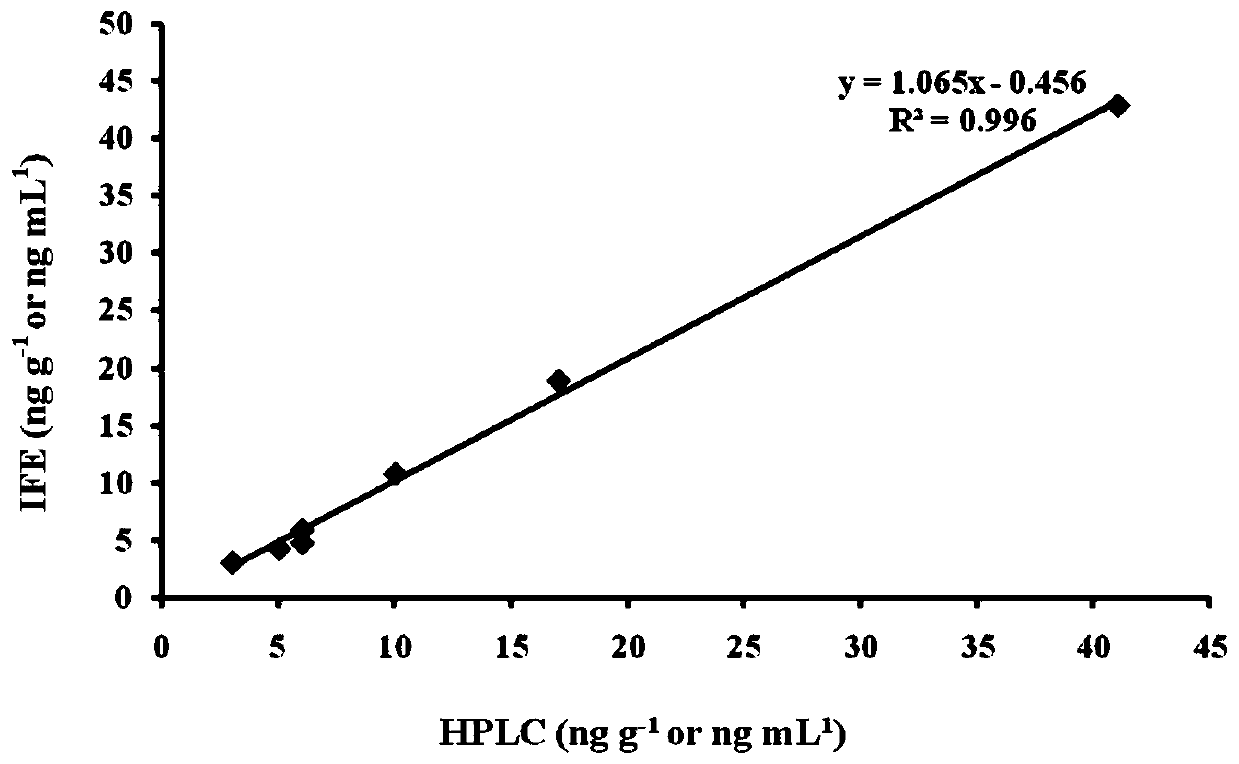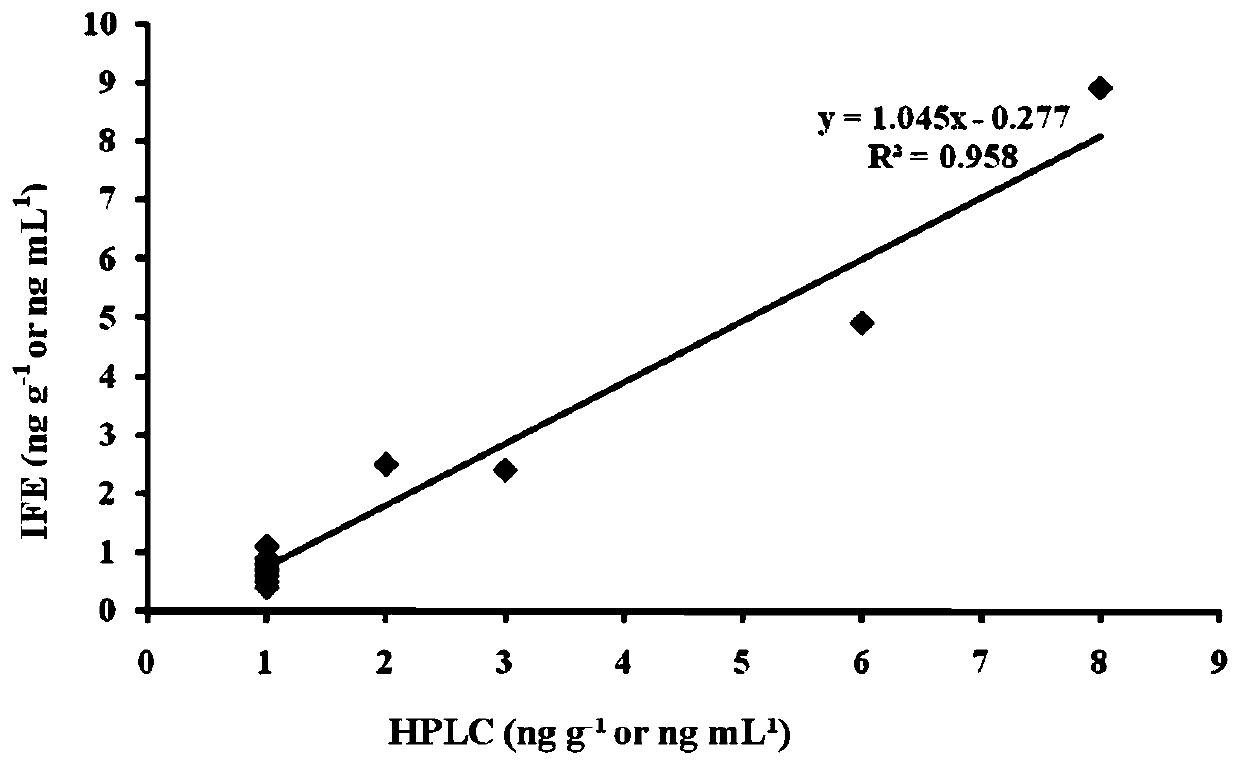Method for detecting thiamethoxam residues
A technology of thiamethoxam and antigen, which is applied in the field of detection of thiamethoxam residues, can solve problems such as poor sensitivity, enzyme activity and stability susceptible to environmental interference, and difficult quantitative analysis, achieving high accuracy and reliability, and solving Trace determination, good selectivity effect
- Summary
- Abstract
- Description
- Claims
- Application Information
AI Technical Summary
Problems solved by technology
Method used
Image
Examples
preparation example Construction
[0027] The present invention does not specifically limit the source of up-conversion nanoparticles and thiamethoxam antibodies, and commercially available products can be used. Preferably, the preparation method of the thiamethoxam antibody-UCNPs conjugate includes: using COOH-UCNPs particles with NN-hydroxysuccinimide (NHS) and 1-ethyl-(3-dimethylaminopropyl) The carbodiimide (EDC) is vibrated and activated in an aqueous solution to obtain active particles; the active particles and the thiamethoxam antibody are mixed and reacted in a phosphate buffer to obtain the thiamethoxam antibody-UCNPs conjugate. Preferably, the active particles are washed with phosphate buffer solution and then reacted with thiamethoxam antibody. It is more preferable to rinse in ultrasonic waves. The preferred concentration of the phosphate buffer in the present invention is 0.01M and the pH value is 7.4. In the present invention, it is preferred that the active particles react with the thiamethoxam ...
Embodiment 1
[0037] Preparation of thiamethoxam antibody conjugate
[0038] First, prepare an ultrapure aqueous solution of 0.5 mg / mL COOH-UCNPs particles, add 20 μL NHS (25 mg / mL) and 20 μL EDC (38 mg / mL), shake vigorously for 20 minutes to activate the particles, and then centrifuge for 10 minutes. Discard the supernatant and retain the precipitated active particles. Wash the precipitate with 1 mL of 0.01M phosphate buffer (PB, pH 7.4) under ultrasound for 5 minutes. Subsequently, 19 μL of thiamethoxam antibody (2.1 mg / mL) was added to the UCNPs activation suspension. The mixture was reacted at 250 rpm for 2 hours, and then a 1% bovine serum albumin solution was added to the mixture to block for 30 minutes. After centrifugation, discard the supernatant and resuspend the sediment in 0.03 containing 1% bovine serum albumin (w / v), 0.1% Tween-20 (v / v) and 1% trehalose (w / v) M PB (pH 7.4) stock solution. Thiamethoxam antibody UCNPs are stored at 4°C. If the particles become aggregated or flo...
Embodiment 2
[0046] Sample pretreatment and standard addition recovery test
[0047] Buy apples, peaches, and cucumbers from supermarkets. In the sample pretreatment, the samples are highly homogenized and turned into liquid juice. They are first confirmed to be free of thiamethoxam by UPLC-MS / MS. It is also used in the standard recovery test. A small amount of thiamethoxam was added to each sample to obtain different spiked levels. Each sample (2.0 g) was extracted with 10 mL of 0.01 M PBS (pH 7.4) with shaking for 1 minute, and then filtered through a 0.22 μM membrane. The filtrate was diluted 4 times with 0.01m PBS (pH 7.4) and analyzed.
[0048] Test actual samples
[0049] In practical application, using IFE-based immunoassay and UPLC-MS / MS technology, 15 samples of apples, peaches and cucumbers from different origins were analyzed simultaneously to evaluate the correlation between the two methods.
[0050] Table 1 Using the method of Example 1 to detect the recovery rate of the added samp...
PUM
 Login to View More
Login to View More Abstract
Description
Claims
Application Information
 Login to View More
Login to View More - R&D
- Intellectual Property
- Life Sciences
- Materials
- Tech Scout
- Unparalleled Data Quality
- Higher Quality Content
- 60% Fewer Hallucinations
Browse by: Latest US Patents, China's latest patents, Technical Efficacy Thesaurus, Application Domain, Technology Topic, Popular Technical Reports.
© 2025 PatSnap. All rights reserved.Legal|Privacy policy|Modern Slavery Act Transparency Statement|Sitemap|About US| Contact US: help@patsnap.com



